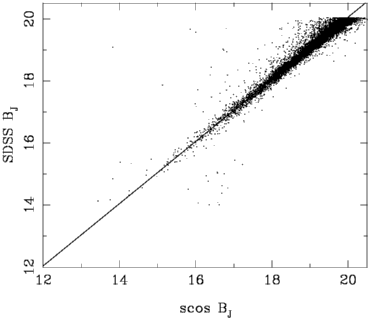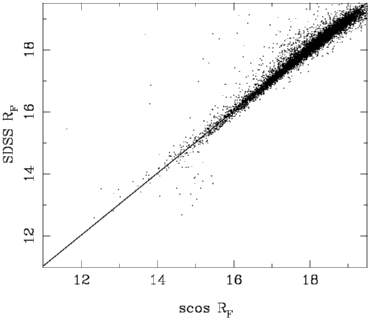Photometric Calibration
1. SuperCosmos data
The 2dFGRS final release differs from the 100k preliminary release in that the bJ photometry has been recalibrated. Also, red photometry from the UKST rF plates is now available.
The original 2dFGRS magnitudes were based on APM scans of the UKST bJ plates, but the APM never completed scans of the rF plates. This has now been completed by the SuperCosmos measuring machine. This has some advantages in precision with respect to the APM, so a first step was to calibrate the SuperCosmos bJ and rF data, followed by recalibration of the 2dFGRS APM magnitudes by comparison with SuperCosmos. See Hambly et al. (2001, MNRAS, 326, 1279) for details of the basic SuperCosmos catalogue, and also http://www-wfau.roe.ac.uk/sss/.
The SuperCosmos recalibration is APM-like in that it matches overlaps. Each plate is given a 2-coefficient transformation:
SuperCosmos mag = a * true mag + b
each plate is also allowed to have a different degree of differential de-sensitization with radius. Such systematics can differ from plate to plate, and the differences can be accurately measured from the overlap data. The typical effect is 0.02 mag at 2.5 degrees radius, and 0.08 mag at the corner of the 5x5 degree region - but these numbers can change by factors of 2 or more from plate to plate. The 3 free parameters per plate are allowed to float in order to optimise the agreement of the overlaps. Plates at low latitude, where the stellar contamination is high, are excluded.
The magnitudes are placed on an absolute scale using SDSS in 33 plates and EIS in 8. Both these datasets cover both Galactic hemispheres. The SuperCosmos data seem to be very good and homogeneous:
- The magnitudes are "quasi-linear": SuperCosmos mag = a * SDSS + b works without the need for quadratic terms.
- the random error is small: a sigma-clipped rms in bJ SuperCosmos-SDSS of only 0.09 mag on a single plate. The corresponding figure for 2dFGRS is about 0.15 mag. The error in rF is 0.10 mag.
The agreement with SDSS data and quasi-linear calibrated SuperCosmos data is shown below.


In addition, the calibration at bright magnitudes is constrained so that the median extinction-corrected optical-2MASS J colours are uniform within the errors. This is done separately for bJ and rF. A small final perturbation to the calibration is performed so that the median extinction corrected bJ-rF colours are uniform within the errors. The final dispersion in median bJ-rF values from plate to plate is about 0.02 mag. Since the 2MASS zero points are estimated to be good to 0.03 mag rms over the whole sky, the SuperCosmos optical data should now be calibrated to the same accuracy.
2. UKST colour terms
In making the absolute calibration, the SDSS EDR data were placed on a true AB95 scale by applying the offsets from Blanton et al. astro-ph/0210215. The colour corrections from Fukugita et al. (1995, PASP, 107, 945) were then assumed, to relate SDSS photometry to Johnson-Cousins:
B = g + 0.217 + 0.419(g-r)
V = g - 0.002 - 0.533(g-r)
R = r - 0.155 - 0.089(g-r)
The UKST colour equations were then determined to be
bJ = B - 0.304(B-V)
rF = R + 0.163(V-R)
forcing the UKST photometry to share the Johnson-Cousins zero point. In direct SDSS units, this is
bJ = g + 0.150 + 0.130(g-r)
rF = r - 0.130
3. SuperCosmos recalibration of 2dFGRS
When the SuperCosmos bJ data are compared to the 2dFGRS APM photometry, there is evidence for a small nonlinear term, which can be eliminated by applying a correction
bJ' = bJ + 0.033( (bJ-18)^2 - 1 ) bJ > 15.5 (fixed bJ'-bJ for < 15.5)
One can now fit quasilinear corrections to the APM photometry to optimise the agreement with SuperCosmos:
bJ'' = A bJ' + B
The coefficients A and B are determined for each plate. The numbers bJ'' are the final 2dFGRS magnitudes given in the release database, although the original photometry and the 100k recalibration are included for completeness, as well as the SuperCosmos magnitudes. If colours are desired, the SuperCosmos photometry is to be preferred, as the accuracy of 0.09 mag rms per band is superior to the 0.15 random error from the APM photometry. Nevertheless, since the selection was made in terms of the APM magnitudes, these must be retained for some purposes.
4. Matching APM and SuperCosmos sources
Finally, some explanation is in order of how the appropriate images in the SuperCosmos and APM data were matched. This is not trivial, since SuperCosmos has the ability to deblend images. This is desirable in the case of galaxy pairs, but bright galaxies can tend to be broken up artificially. In the end, a pragmatic approach was taken which aims to pick out the cases where there is an issue over how much deblending is desirable.
4.1 bJ matching
Six classes were defined for matching APM sources with SuperCosmos, having adjusted the APM photometry to best match SuperCosmos.
- B Class 1: Deblended or isolated images within 2" and 0.2 mag.
- B Class 2: A blend within 2" and 0.2 mag (but only if no class 1 candidate). Especially for bright galaxies, SuperCosmos blends match what the APM did much better - and it is sensible not to split up such cases.
- B Class 3: Only one candidate object within 8" (irrespective of whether it's a blend), which matches to 3" and 0.3 mag.
- B Class 4: Choose the best object via min chi^2 < 2, where chi^2 = (delta rad/2")^2 + (delta m/0.2)^2. Consider blends and non-blends.
- B Class 5: As for class 4, but min chi^2 > 2.
- B Class 6: Objects with no ID - objects where there is "no" counterpart within 8 arcsec. The definition of "no" depends on depth: a cutoff was imposed at galaxy-corrected SuperCosmos B=20.5; fainter than this, the APM source is effectively not real.
Statistics for the bJ matching:
B Class 1 = 88.6% B Class 2 = 6.3% B Class 3 = 2.3% B Class 4 = 0.6% B Class 5 = 1.7% Total IDs = 99.4% B Class 6 = 0.6% Total no IDs = 0.6%
The objects without ID were included with the sources rejected on the basis of visual examination.
4.2 rF matching
Now we have to find rF counterparts for the objects in bJ classes 1-5. The matching was done with the SuperCosmos positions, rather than the APM position, which allows a tighter tolerance. It seemed sensible to consider blends and non-blends separately, since matching a blended bJ source to a deblended rF component could generate incorrect colours.
Again, a number of classes are defined:
- R Class 1: Take B classes 1-4, where we probably have the right object, and accept a counterpart with the same blend flag within 1".
- R Class 2: As for R class 1, but with B class 5 objects. Many of the latter are dubious, but a good R match probably verifies them.
- R Class 3 For any B class, accept the closest object within 2", provided blend flags match.
- R Class 4: As for R class 3, but accept matches with different blend flags.
- R Class 5 Closest with separation > 2" and blend flags match.
- R Class 6 Closest with separation > 2" and different blend flags.
- R Class 7 No R object within 30" to the plate limit. There are few of these, and most are probably junk.
Statistics for the rF matching:
R Class 1 = 81.2% R Class 2 = 0.6% R Class 3 = 4.9% R Class 4 = 9.1% R Class 5 = 2.5% R Class 6 = 1.6% R Class 7 = 0.0%